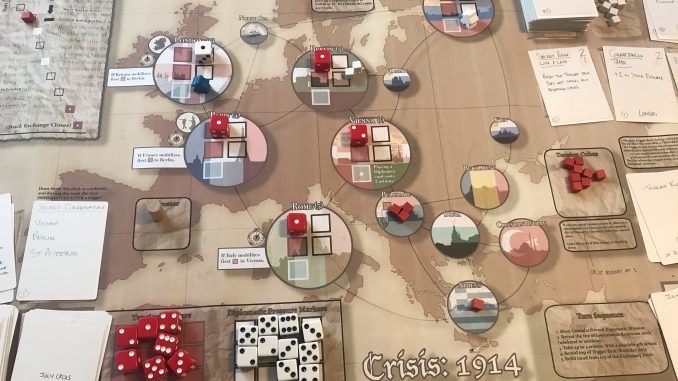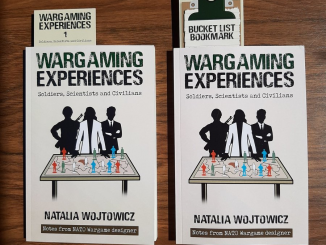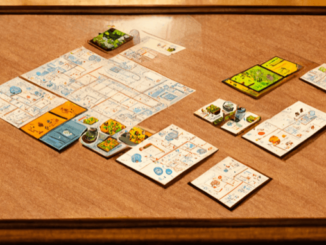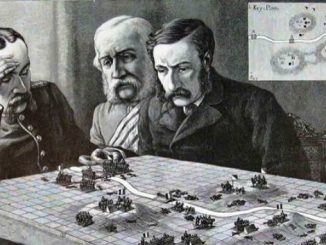
From their commercial birth in the 1950s, board wargames became immensely popular in the 1970s and 1980s. Annual sales in 1980 were 2.2 million units. But then they became less popular. In 1991 annual sales had plummeted to 400,000 units. Now, in 2020, they are popular[1] again. They are the genre with the second largest market share within the overall exceedingly buoyant board games market. Wargames (and strategy games, which aren’t quite the same thing and include more abstract game designs) are second only to Educational games, with 19.66% of the market in 2018, expected to rise to 20.74% by 2024, with a growth rate of 14.49% over that span rising from a global revenue of $2.42 billion (2018) to $4.46 billion (2024).[2] Although these figures are pre-pandemic, numerous board game publishers are citing sales figures every bit unimpinged by Covid-19, if not better than pre-pandemic projections.[3]
Why? Why this rise, decline, and resurgence?
First, why the popularity of board wargames in the 1970s-1980s?
- Since their emergence in the 1950s, wargames continued to offer new gaming experiences. New rules, new publishers, new designers, new historical, fantasy and sci-fi settings.
- They were value for money. In return for the price of a meal they gave players tens, if not hundreds of hours of gameplay.
- They intersected with hobbyists of miniature wargames, history, fantasy, and sci-fi. Of course, D&D and RPGs were originally born out of wargaming.

Why the decline in the 1990s to the early 2000s?
- The most prolific producer of games, SPI, hit financial trouble, and was bought out by TSR.[4] No meaningful new products were developed, and the circulation of their company magazine Strategy & Tactics plummeted.[5]
- There was competition in related analog sectors. The sustained popularity of Games Workshop’s Warhammer brand, the popularity of RPGs, and the rise of collectable card games, would all seem to have had a part to play in cannibalising the same core audience, pulling players away from the hobby. D&D was still the most popular RPG, but there was now also Tunnels & Trolls (1975), Traveler (1977), Runequest (1978), Space:1889 (1988), and numerous others. These games were more than just games – they were entire game systems demanding large amounts of time to fully explore with effectively limitless potential for play. Perhaps still the best known and most commercially successful collectable card game, Magic: The Gathering was first released in 1993.[6]
- There were problems from within the board wargaming industry too. In this period we also see games becoming more complex and ‘denser’, with behemoth rulebooks, becoming longer to understand and play, with play times extending to 20 hours, and, more realistically, far beyond. Games in question are such as The Civil War: 1861-1865 (1983) and The Korean War: June 1950-May 1951 (1986).[7] From BoardGameGeek (BGG) scores it seems these games were well enough received at the time, but they did a poor job of introducing new players to the hobby. As designer Jason Matthews has described it: “War-gaming destroyed itself.”[8] In contrast, RPGs were developing a whole sub-genre of easy on-ramp experiences in the form of Fighting Fantasy and Choose Your Own Adventure books well-suited to bringing pre-teens and early teens into the hobby. In its own right,Games Workshop conducted a masterclass in retaining and expanding an audience.
- Digital games were gaining traction.[9]
- The net result was a great deal of pressure on the board wargaming industry facing a contracting audience base. From wargame sales of 2.2 million units in 1980 they were 400,000 in 1991.[10] GDW shut down in 1996.[11] Wizards of the Coast purchased TSR in 1997, bringing the curtain down on the remnants of SPI too.[12] Then, in 1998 Monarch sold Avalon Hill and its Victory Games subsidiary to Hasbro.[13]

Why the re-popularization?
- To some extent wargames are now more popular because they are no longer just wargames. We now have wargames that erode distinct borders defining what a wargame is. Games like Pandemic: Fall of Rome (2018) and The Grizzled (2017) are certainly set in times of war (the end of the Roman Empire, and in World War One), and the key conflict comes in the form of strategic and tactical military threats – although really personal and group survival – respectively. But these are cooperative games that appeal to a broader audience than a traditional one-versus-one competitive strategy game/wargame. Twilight Struggle (2005), in BGG’s top 10 for a decade and a half, and at number 1 for much of that time, isn’t just a wargame. It captures some of the international political dimensions of the Cold War too. With 1960: The Making of a President (both games co-designed by Jason Matthews and sharing some similarities in mechanics) we have an election battle, not a wargame. But given the crossover in mechanics (and comments on BGG) we are seeing wargamers play it, and that may be feeding back the other way into wargames. Root (2018) is a wargame, but its woodland critters give it an appeal to a broad demographic – raising over $600k with over 8k backers on Kickstarter.
- We’re also seeing wargames playable in numbers beyond two. We previously had some games suitable for 3 or more players, and that proportion may not have shifted much today, and 2 player games are
likely still the most common in the genre. But we are seeing more games designed with solo play specifically in mind. Some wargamers exclusively play solo. The Solitaire Wargamers group on Facebook has 10,718 members at the time of writing (late October, 2020), which compares well with 13,549 in the group called Wargamers. - Today’s wargames cover a variety of topics, some of which have traditionally been under-explored. We have games on counter insurgency (COIN) conflicts with asymmetric warfare – in fact we have an ever-expanding series of COIN games published to much critical acclaim by GMT. We also have wargames on the traditionally under-explored intersections between military and political objectives. Churchill (2015) has the USA, USSR, and Britain working together to defeat the Axis powers, but still competing for position in a post-war world. Versailles: 1919 (2020), and The Congress of Vienna (forthcoming) work with a similar design approach with allies in competition with each other.
- Some of today’s wargames are incorporating popular mechanics from other genres – mechanics such as card drafting ( A Few Acres of Snow, 2011), hand management ( Ancient Civilizations of the Inner Sea , 2019), and hidden traitors ( Hidden Strike: American Revolution , forthcoming).
- The components of today’s wargames are generally far superior to what was boxed, or frequently bagged, prior to the 2000s.
- Play times are shorter.
- Complexity and rule density have been reduced.
- Connected to all of these points, is the proliferation of non-hex based game boards. We’ve had area control since at least Risk (1959), and point to point since at least 1974, and they’ve been popular since A House Divided (1981), but these are now popular in most of the more innovative wargames of recent years. We now also have area influence/majority maps as a concept and fixed maneuver maps too. This reduction of the use in hexes across the wargames sector, and especially within the most innovative designs, seems significant. Hexes work well for specific tasks:
- for regulated movement with known modifiers, and for easily calculable ranges. But they also impose a certain aesthetic and, I suspect, conjure certain expectations in non-wargamers (and plenty of wargamers) that are impediments to engagement. To be sure there are players who respond fondly to the notion of clasping long handled tweezers to manipulate large stacks of half inch pieces around detailed hex grids broken into terrain modifiers. Go to the wargaming conventions and you will see it. But there are more potential players who don’t want this than do. Shifting the board aesthetic of wargames may have helped facilitate both engagement and innovation in more recent wargames.
How long this rise might continue is a different topic. But for now, the picture is rosy. In truth, I suggest, it is also altogether a more sparkling shine than the first surge of popularity had. Topics today are more diverse, as are perspectives, designs are more accessible, and components are higher quality. We might well ask – was the first golden age really so golden?
References and further reading
1
https://archive.org/stream/CompleteWargamesHandbookDunnigan/Complete-Wargames-Handbook-Dunnigan_djvu.txt
2 Board Games Market: Global Outlook & Forecast 2019-2024. Arizton: Advisory & Intelligence, (2019), pp.134-138.
3 https://www.insidehook.com/daily_brief/games/pandemic-board-game-sales https://www.foxbusiness.com/markets/hasbro-earnings-q3-2020?fbclid=IwAR2SZztg8ulBpNtKQSO-PlwCu45VgB-Zbw1Ll52xuOeenqXnLm6kwi6FWbM Other publishers, although not making public declarations, are also seeing similar patterns of financial health.
4 https://grognard.com/zines/so/so43.txt
5 https://en.wikipedia.org/wiki/List_of_SPI_games ; Owen, S . “The History of Wargaming 1975-1990” .
6 20 million players, as of 2015.
https://web.archive.org/web/20060901100217/http://faculty.bschool.washington.edu/skotha/
website/cases%20pdf/Wizards%20of%20the%20coast%201.4.pdf
7 https://boardgamegeek.com/boardgame/7349/korean-war-june-1950-may-1951, https://boardgamegeek.com/boardgame/2081/civil-war-1861-1865
8 https://web.archive.org/web/20180907202809if_/https://www.washingtonpost.com/lifestyle/magazine/the-cold-war-themed-board-game-that-feels-more-relevant-than-ever/2018/07/16/45be9be4-7a4e-11e8-93cc-6d3beccdd7a3_story.html?utm_term=.486ed746687a
9 Between 2000 and 2020 Creative Assembly, developer of the SEGA published Total War franchise, have sold more than 34.3 million Total War games, and 44.1 million units of DLC (downloadable content). Personal correspondence with Gareth Edmondson, Creative Assembly Studio Director.
10 https://archive.org/stream/CompleteWargamesHandbookDunnigan/Complete-Wargames-Handbook-Dunnigan_djvu.txt
11 https://www.gamecareerguide.com/features/327/on_game_design_a_history_of_video_.php?page=2
12 https://www.rpg.net/columns/briefhistory/briefhistory1.phtml
13 https://web.archive.org/web/20130203105143/http://www.gis.net/~pldr/fah.html
- The Re-popularization of Commercial Wargames - 8th November 2020





As a current player of many wargames, old and new, they sure don’t seem to be very popular. Not even close to any other group of games I can think of. And that’s even with the dubious inclusion of any sort of political game as a wargame.
“We might well ask – was the first golden age really so golden?”
If not, only for reasons that had very little to do with the games themselves (no internet to connect to opponents and organize play). In that time it was common, say, in colleges to just have other people you knew who lived in the dorm to get together and play wargames. I’d have loved to have that environment today.
You say that in 1991 sales had dropped to 400,000 units – and then claim that they are on the rise, citing a 2024 forecast of $4.46 million. That’s 400,000 units at $11.15 each – and I’m sure even back then commercial board wargames were more expensive than that.
Hi Francis. I’m not the author of the piece, but I think potentially the figure should read ‘billion’ rather than ‘million’, if we are talking about revenue (which I think we are), rather than income. I am looking at the report for the board game market from 2021-26 from the same source, and it says the total revenue for the sector is due to rise to 30 billion by 2026. So if the wargames share of that is around 20% and we shave off a bit off the total value to account for looking at 2024 rather 2026 – then 4.5 billion starts to look about right (or maybe even a little conservative). I will ask Maurice to check the other source (which I don’t have access to at the moment). Thank you for your comment.